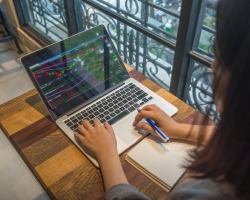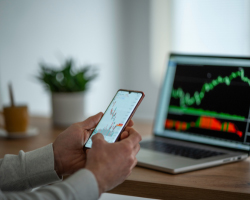Day Trading 2023: How to Day Trade
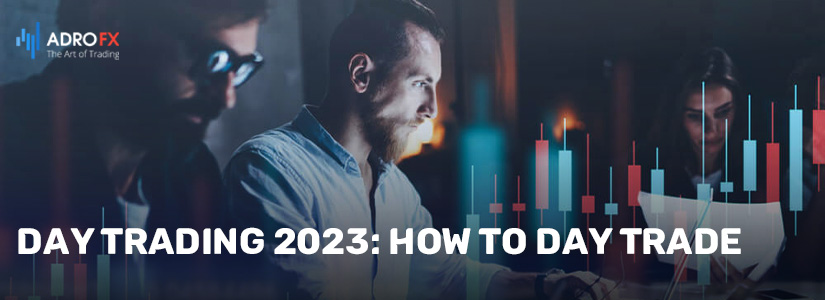
Traders can use different strategies in practice - from the simplest, suggesting buying and holding assets for some time, to more complex financial manipulations, involving the use of different assets and technical tools. One of the ways of forex trading, the use of which allows one to earn good money, is day trading. Let us find out what that is and what strategies it includes.
What Is Day Trading?
Day trading, as the name implies, involves making trades within one trading day, without carrying them over to the next day. As a rule, this type of trading is popular among newbies, because they think that quantity necessarily turns into quality, i.e. the more trades, the more profit received. It is also worth noting that newbie day traders are the ones who usually violate traders' discipline and ignore the trading plan because the pace of trading determines fast decision making which requires a certain experience. Moreover, a beginner is not yet ready to get rid of excitement and the thirst for fast profit, which is what attracts them to intraday trading.
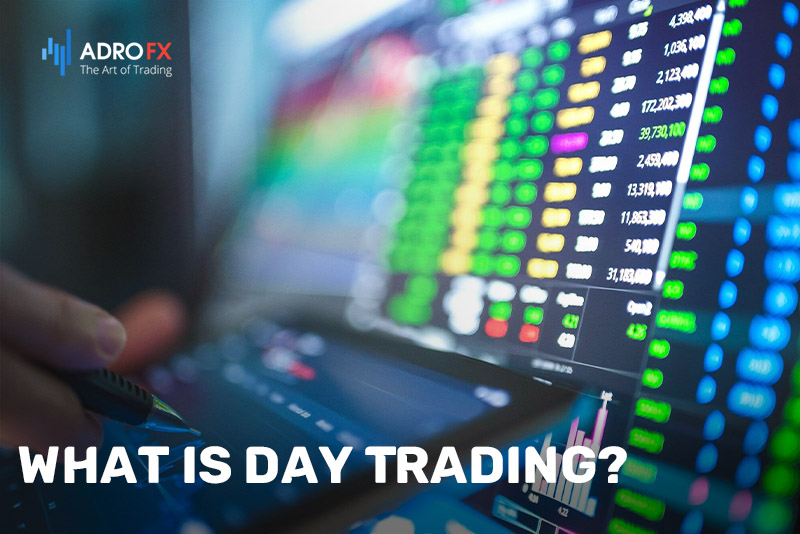
The range of time frames used in intraday trading is wide, from M1 to H1, but newbies for some reason prefer M5 or M15, believing that this will help them timely react to every price movement and gain profit. Often, because of the market noise inherent in these time frames, their trades are closed at a Stop-Loss, generating losses.
This does not mean that intraday trading is unprofitable. Quite the opposite. Trading intraday can and will be profitable, but only in case of unconditional adherence to trading discipline, competent planning of actions, and denial of all emotions.
Day trading practically does not involve the use of fundamental analysis. The main thing here is not to give in to emotions and work out the necessary algorithms like a robot.
It is also important to be able to analyze the mistakes and look at the trading process from the outside. Do not forget about money management.
You can not use all funds from the deposit, because it is impossible to avoid losing trades. Allowed is 2-5% of the deposit, and if there are a lot of funds in the account, then no more than 10%. If the chosen trading strategy is tested on history, then one way or another, the trader will be in the black.
Most often technical analysis is used in day trading, so it is recommended to test Support and Resistance levels, graphical and candlestick patterns, indicators, and oscillators on a demo account.
Strategies
Day trading is a complex style of trading. For this reason, the next principles should be followed:
- Trading in the range of 40-60 pips is considered optimal. Usually, the price of currency pairs does not often change within a large range;
- Besides technical analysis, trading based on news is also significant. An important economic news release can influence the rise or fall of price by more than 60 pips;
- Trading in the trend, which can be clearly seen in higher time frames due to minimal market noise, is mandatory;
- As volatility increases, strict profit and loss limitation is important;
- To increase the chances of making large profits, you should trade in a volatile market. You should not forget that the potential loss will also be larger. The GBP/CHF pair has the highest volatility. To reduce the risks, you should choose the pair EUR/USD;
- The Internet with high speed is necessary for trading in short-term periods.
Let us consider some strategies day traders find profitable.
Scalping
Scalping is without exaggeration the oldest and most popular strategy used in day trading. This simple strategy involves technical analysis of the financial asset you want to trade. Once you have determined the clear direction of the asset's price movement, you should open a position and close it after a few minutes.
For example, when the price of an asset moves upward, scalpers can enter into a buy position. Immediately after the price begins to correct, they exit the trade and enter a sell position on the asset. The buying and selling process continues repeatedly until the scalper's goal is reached.
Scalping is an ideal trading strategy during periods of low volatility. When volatility is low, assets tend to trade sideways, providing solid entry and exit positions.
Professional scalpers open and close dozens of positions in a single day. By doing so, they generate small profits from each trade in a matter of minutes. The chance to make a profit on each small price movement is the ultimate goal of this strategy. One of the advantages of a scalping strategy is that it limits your exposure to significant risks when entering and exiting a trade quickly.
Scalping also stands out among other intraday trading strategies because it does not require much actual knowledge of the asset being traded. The only thing you need to have a clear understanding of is the direction in which the price of the asset may move.
However, you should always approach scalping with great caution. For instance, you should never open a position just before the publication of important economic data. Markets tend to be extremely volatile when significant economic data is published.
Although not all brokers allow this strategy, many still allow their clients to use it. The low spreads offered by some brokers allow traders to enter and exit trades without significant financial costs, which is very important when using an intraday trading strategy.
Reverse Trading
Reverse trading is usually practiced by traders in a more or less calm market. At this time, market movement is often limited to a certain range in which the price moves in one direction or the other, without a specific direction. Traders determine the key levels from which the price bounces and place short-term trades to make small profits.
This approach usually uses support and resistance lines and fundamental analysis data.
Before you start reverse trading, you should make sure that there are no important news releases scheduled for the session, including speeches by politicians, because such events can trigger strong price movements and lead to losses.
Once you have analyzed the market for the influence of fundamental factors, you should proceed with technical analysis and determine the current support and resistance levels.
Key levels identified by traders using this strategy usually include the highs and lows of the previous session, pivot points, Fibonacci levels, and zones where these levels overlap. Such overlaps are known as "mergers" and represent an excellent range of price zones from which prices will bounce during the trading session.
Price maneuvers can vary, but traders tend to take a small profit of a few pips rather than holding open positions for several sessions.
Reverse trading shows itself best when the market does not move in any one direction. However, you should trade with caution, because otherwise, you can incur substantial losses.
Momentum Trading
Impulse trading is less about "accurate" entries. It is more designed for the strength of the price movement and its duration. Traders are not looking for pullbacks or price breakouts from any level but prefer to move more or less in the general direction of the prevailing trend.
This type of trading is based more on fundamental factors, but also involves the use of technical indicators such as Moving Averages and oscillators, which provide trading signals.
Traders resort to impulse trading when they anticipate a prolonged movement in the price of the asset they plan to trade. For example, if traders see an impending interest rate change in a country, they will immediately buy or sell that country's currency when the change takes effect. Other examples include geopolitical events which can last for months or even years.
During such important changes, professional traders will be looking to open long-term trades that last several weeks or months.
Because of the time-consuming nature of this approach to trading, traders are not much concerned about entry points. They simply wait for the surface technical analysis to allow them to open a potentially profitable long-term trade.
A popular indicator for this type of trading is the Moving Average with a period of 200. As a rule, traders wait for the price to cross the Moving Average line on any side to enter the trade, and as soon as it happens, they enter the market.
Exits from the position are usually determined by the same fundamental analysis indicators as when entering. Traders monitor economic and geopolitical events and make decisions about how to manage current trades based on this information.
Pros and Cons of Forex Day Trading
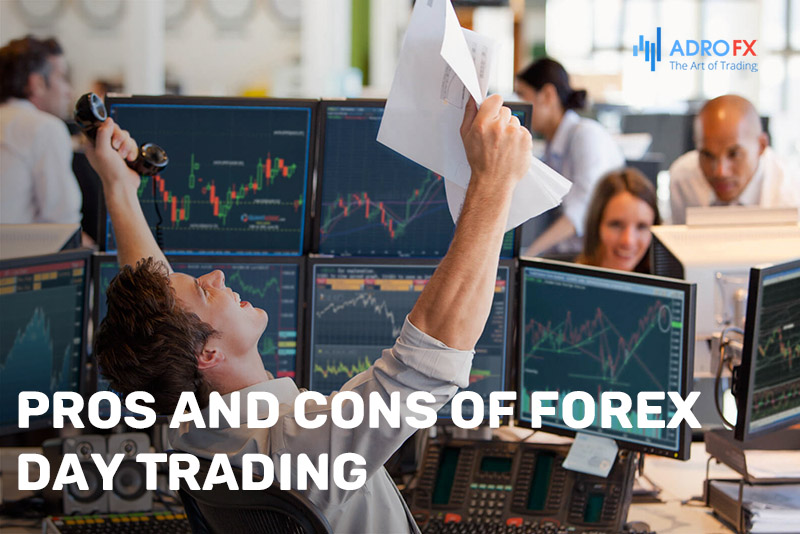
Like any other approach, day trading has both advantages and disadvantages that should be considered when you look for the best system to work with.
Let us start with the pros of forex day trading, and the first one is that you don't need a lot of capital to start day trading, as each trade can have a profit of just a few pips. The low level of risk for each position attracts cautious traders.
Among other advantages are:
High profits compared to alternative methods. If a trade is opened with the expectation of closing in a month, the cost will inevitably fall into a correction. Thus, a significant portion of the time an open position does not work for the benefit of the trader. It is good if the price passes 400 points within a month. But one day's value can pass 100 points. The ideal way to make a good profit is a series of profitable intraday trades. However, you should be prepared for losing trades. The real profit is lower than expected, but it is still higher than medium-term trades. The obligatory condition is the proper organization of trading by the trader.
Free time. The trader himself determines how much and in what way he works. Among other things, there is an opportunity to refuse a new intraday cycle, while with an open trade in the medium term, it is necessary to monitor the price movement constantly.
In general, day trading opens up the possibility of more significant earnings.
Despite all the positive moments of day trading, we still must mention some disadvantages.
It is more suitable for professional traders. Too low predictability of the price movement becomes an additional factor of danger. You can inadvertently lose your money.
Small Stop-Losses and profits. It is impossible to place a large Stop-Loss. First, the price will not manage to pass too long distance during the day, and second, the risk of losing money increases. Some players report psychological pressure in connection with this feature.
Time. Speculation within the day demands lots of responsibility and readiness to wait for a long time for the appropriate moment to enter the market. Not every trader is ready to sit for a long time in front of the monitor waiting for the moment.
Discipline. Day trading is much more disciplined. A trader learns to control emotions. Only this approach will provide a high profit.
Conclusion
Intraday trading allows only experienced traders to make good profits. All considered trading strategies should be tested on a demo account. It will help to acquire skills for making the right decisions very quickly.
If a beginner decides to try day trading, it is better to choose pullback trading. However, it is important to understand what this breakout is and what trend will follow it. One should not pay attention to insignificant corrections, as it is impossible to gain a good profit from them, but it is easy to bring the deposit to zero.
Beginners should remember that you can count on profitable trading only after preliminary training, especially studying the methods of technical analysis. It studies the factors which create the price movement, such as money flow, public sentiment, supply and demand analysis, market correlations, and others.
About AdroFx
Established in 2018, AdroFx is known for its high technology and its ability to deliver high-quality brokerage services in more than 200 countries around the world. AdroFx makes every effort to keep its customers satisfied and to meet all the trading needs of any trader. With the five types of trading accounts, we have all it takes to fit any traders` needs and styles. The company provides access to 115+ trading instruments, including currencies, metals, stocks, and cryptocurrencies, which make it possible to make the most out of trading on the financial markets. Considering all the above, AdroFx is the perfect variant for anyone who doesn't settle for less than the best.


